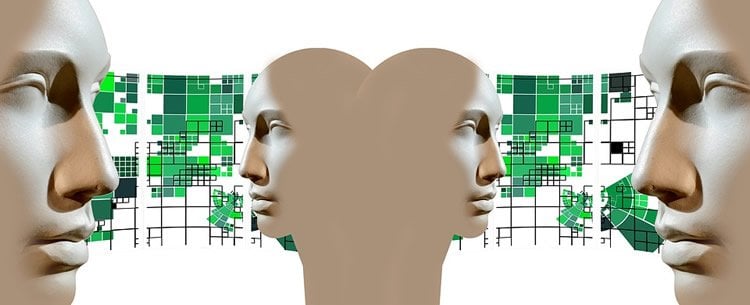Summary: Researchers report blind people need additional timing cues to accurately judge relative locations of sounds, but those without visual impairments who were blindfolded could judge the relative location of sounds independently from timing cues.
Source: Cell Press.
It’s a popular idea in books and movies that blind people develop super sensitive hearing to help navigate the world around them. But a study, published August 1 in the journal iScience, shows that, in at least one situation, blind people have more trouble discerning the location of sounds than do people who can see.
Researchers in Italy found blind people needed additional timing cues to accurately judge the relative location of sounds played from a line of speakers. However, people who aren’t visually impaired (but were blindfolded for the study) could judge the relative location of sounds independently from timing cues.
“This work teaches us that our audio-space representation is mediated by our visual experience,” says first author Monica Gori of the Istituto Italiano di Tecnologia. “In absence of vision, auditory spatial skills are not always enhanced – and in some cases, such as in the space bisection task studied here, these can be impaired.”
Gori and colleagues recruited 17 blind people and 17 age-matched sighted people for the study. All participants were blindfolded before entering a room and sat before a horizontal line of 23 speakers. From left to right, three of the speakers played a beep and participants were asked to judge whether the second beep originated from a speaker closer to the first beep or the third beep.
The exercise resembles a situation in which a blind person is seated opposite three people along a large table and wants to figure out where people are sitting by listening to them speak.
In the first round of the experiment, a uniform time delay of 750 milliseconds followed each beep before another beep was played. In the next two rounds, delays between the beeps were timed to be either directly proportional to the distance between the speakers playing the beeps or indirectly proportional. The study participants didn’t know the timing of the beeps was manipulated in this way. While the beeps always moved from left to right along the line of speakers, an algorithm randomly selected which three speakers would play the beeps. Researchers also performed a control experiment in which participants were not asked about location, but whether the second beep played closer in time to the first or last beep.
Sighted people in the study could generally judge the relative position of the beeps no matter how the beeps were timed (and despite being blindfolded). However, timing greatly influenced the judgement of the blind participants.

Blind participants could most accurately judge the position of the beeps when the delay between beeps was proportional to the physical distance between the speakers. But blind individuals had more trouble judging the position when there was a uniform delay between the beeps. And when the time delay was mismatched and inversely proportional to the beeps, blind participants were more likely to mismatch the location of the beeps. For example, blind participants assumed a longer delay between beeps was associated with a longer distance between beep locations, even when the reverse was true.
“This result suggests that blind individuals assume a constant velocity of objects in space and use the temporal cue to infer a sense of space,” says Gori.
Gori and her colleagues have preliminary data showing that young children use timing cues to judge spatial distance between sounds. This may mean that the brain uses cross-sensory interactions during development to build spatial representations.
“I would like to study how this spatial and temporal interaction emerges in blind children and to study the brain mechanisms associated with this,” says Gori.
Funding: This study was supported by the weDRAW EU project.
Source: Carly Britton – Cell Press
Publisher: Organized by NeuroscienceNews.com.
Image Source: NeuroscienceNews.com image is in the public domain.
Original Research: Open access research for “Temporal Cues Influence Space Estimations in Visually Impaired Individuals” by Monica Gori, Maria Bianca Amadeo, and Claudio Campus in iScience. Published August 1 2018.
doi:10.1016/j.isci.2018.07.003
[cbtabs][cbtab title=”MLA”]Cell Press”Blind People Depend on Timing Cues for Some Spatial Awareness.” NeuroscienceNews. NeuroscienceNews, 1 August 2018.
<https://neurosciencenews.com/timing-blind-spatial-awareness-9645/>.[/cbtab][cbtab title=”APA”]Cell Press(2018, August 1). Blind People Depend on Timing Cues for Some Spatial Awareness. NeuroscienceNews. Retrieved August 1, 2018 from https://neurosciencenews.com/timing-blind-spatial-awareness-9645/[/cbtab][cbtab title=”Chicago”]Cell Press”Blind People Depend on Timing Cues for Some Spatial Awareness.” https://neurosciencenews.com/timing-blind-spatial-awareness-9645/ (accessed August 1, 2018).[/cbtab][/cbtabs]
Abstract
Temporal Cues Influence Space Estimations in Visually Impaired Individuals
Many works have highlighted enhanced auditory processing in blind individuals, suggesting that they compensate for lack of vision with greater sensitivity of the other senses. Few years ago, we demonstrated severely impaired auditory precision in congenitally blind individuals performing an auditory spatial metric task: their thresholds for bisecting three consecutive spatially distributed sounds were seriously compromised, ranging from three times typical thresholds to total randomness. Here, we show that the deficit disappears if blind individuals are presented with coherent temporal and spatial cues. More interestingly, when the audio information is presented in conflict for space and time, sighted individuals are unaffected by the perturbation, whereas blind individuals are strongly attracted by the temporal cue. These results highlight that temporal cues influence space estimations in blind participants, suggesting for the first time that blind individuals use temporal information to infer spatial environmental coordinates.






